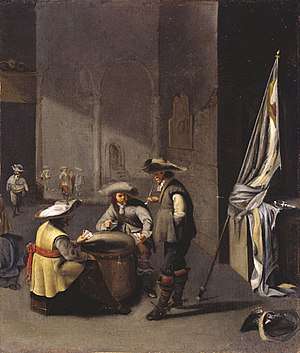Quinze
Quinze, Quince, also known as Ace-low, is a 17th-century French card game of Spanish origin that was much patronized in some parts of Europe. It is considered a forerunner of the French Vingt-et-un, a game very popular at the court of Louis XV,[1] and also a two-player simplification of the modern game of Blackjack.[2]
 | |
| Origin | Spain |
|---|---|
| Family | Gambling |
| Players | 2-6 |
| Skills required | Bluffing |
| Cards | 40 |
| Deck | Spanish |
| Play | Clockwise |
| Playing time | 25 min. |
| Random chance | Easy |
| Related games | |
| Vingt-et-un | |
The game
Quinze is generally admired for its simplicity and fairness, depending entirely upon chance, and not requiring the attention of most other games on the cards, and therefore calculated for those who love to sport upon an equal hazard.[3] It is a card game of chance in which players compete with each other to acquire a hand of 15 points or as close to 15 as possible, hence the game is also known as Fifteen.[4] It is usually played by two persons only, with a full pack of 52 cards.
The play
The cards are shuffled by both players and when they have it cut for deal, which falls to the lot of that who cuts the lowest card, being Ace low and King high, the dealer is then free to shuffle them again. When this is done, the adversary cuts them, after which the dealer gives one card to his opponent and one to himself.[5]
Should the dealer's adversary not approve of his card, he is entitled to have as many cards given to him, one after the other, as will make fifteen, or come nearest to that number, which are usually given from the top of the pack. That is, if the player is dealt a Two and then a Five, which amounts to seven, he must continue going on in expectation of coming nearer to fifteen. If he is dealt an Eight, which will make just fifteen, he, as having the best hand, is sure of winning the game. But if he is overdealt and makes more than fifteen, he loses, unless the dealer should do the same, in which case it is a drawn game, and the players double their stakes thus going on until one of them has won the game by being exactly fifteen or by standing as closest to this.[6]
At the conclusion of each game, the cards are put up and shuffled and the players cut again for deal, and the elder then taken on the advantage of dealing the cards.
References
- Oxford Dictionary of Card Games, David Parlett, p.218 - Oxford University Press ISBN 0-19-869173-4
- Scarne on Card Games, p. 196, John Scane, Dover Publications, NY 2004 ISBN 0-486-43603-9
- Hoyle, Edmund; and L. Dawson. Hoyle's Card Games, Routledge, 1979, p. 220
- Webster's Revised Unabridged Dictionary, published 1913 by C. & G. Merriam Co.
- The Modern Pocket Hoyle, p. 190, William Brisbane Dick - Dick & Fitzgerald, NY 1868
- The Dictionary of Gambling and Gaming, p. 171 - Thomas L. Clark - 1988 - 263 str.
